 The Story Grid is a methodology. It’s a diagnostic tool – not a formula – designed to teach writers how to self-edit and find what’s wrong with their novel and how to fix the manuscript before it goes to a commercial editor. It’s a story CT scan, seeing at the 50,000 foot macro-level, as well as line-by-line at the micro-level, deep inside. The Story Grid is what good self-editors must know about writing a Best Selling novel.
The Story Grid is a methodology. It’s a diagnostic tool – not a formula – designed to teach writers how to self-edit and find what’s wrong with their novel and how to fix the manuscript before it goes to a commercial editor. It’s a story CT scan, seeing at the 50,000 foot macro-level, as well as line-by-line at the micro-level, deep inside. The Story Grid is what good self-editors must know about writing a Best Selling novel.
Shawn Coyne is a highly accomplished editor who developed the Story Grid. He’s right when he says that, in today’s world, a writer must deliver publish-ready material every time. Coyne’s Story Grid system analyzes manuscripts like a left-brain editor thinks – after the creative right-brain writer finishes initial drafts.
The Story Grid focuses on genre fiction.
Genre is a fancy word for managing audience expectations of categories. It classifies stories – crime, thriller, mystery, romance, sci-fi, erotica – the type of stuff that literary snobs turn their nose up at, but what sells in a commercial market and makes publishers (thus writers) money.
Coyne explains the makeup of genre fiction in a five-leaf clover concept:
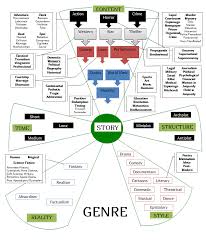 Time – How long will it take to read?
Time – How long will it take to read?- Structure – What’s the plot?
- Style – Comedy? Thriller? Tear-jerker? Fifty Shades?
- Reality – How much suspension of disbelief?
- Content – Takeaway for the reader?
The Silence Of The Lambs is a genre novel. It’s not a long read, has a complex plot, a thriller style, is easily believable, and leaves the reader remembering it forever.
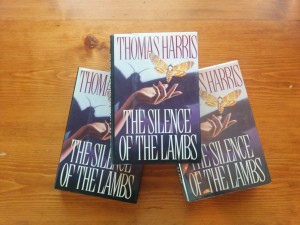 The Silence Of The Lambs is a perfectly crafted story which Coyne analyzes in his book The Story Grid and how his Foolscap, Spreadsheet, and Graph methods apply.
The Silence Of The Lambs is a perfectly crafted story which Coyne analyzes in his book The Story Grid and how his Foolscap, Spreadsheet, and Graph methods apply.
The Foolscap Global Story Grid is Step 1 in Coyne’s system. It represents how an editor thinks of the macro view of the story in no more space than a sheet of foolscap allows; getting the entire outline of a novel in one shot. Very simply, The Silence Of The Lambs is viewed as:
Beginning Hook – Clarice Starling gets job to interview Hannibal Lector to find Buffalo Bill.
Middle Build – Hannibal toys with Clarice, then escapes, leaving Clarice on her own.
Ending Payoff – Clarice catches and kills Buffalo Bill.
It’s the classic 3-Act structure. Expanded, but still on one foolscap page, the Foolscap Grid looks like this:
The Foolscap Grid is a general, checking tool for identifying weakness in overall story and how the collection of scenes builds a gross curve of action with major story movements. It’s the macro analysis.
Step 2 is dissecting individual scenes and plugging them into an Excel spreadsheet. It’s the micro-analysis where the scenes are assigned fourteen values:
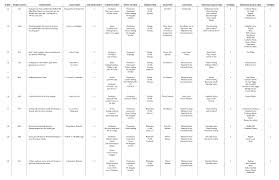 Scene number. Word count. Story event. Value shift. Polarity shift. Turning point. Point of view. Period of time. Duration. Location. Names of onstage characters. Number of onstage characters. Names of offstage characters. Number of offstage characters.
Scene number. Word count. Story event. Value shift. Polarity shift. Turning point. Point of view. Period of time. Duration. Location. Names of onstage characters. Number of onstage characters. Names of offstage characters. Number of offstage characters.
The Spreadsheet Grid clearly identifies what’s happening in each scene and how it contributes to the global story. If any particular value is weak, and not doing its job in furthering the story – not keeping the reader engaged through change and surprise – the writer is able to have a quick ‘meeting with themselves’ and fix the problem, rather than having to wait to get the message back much later from an independent editor.
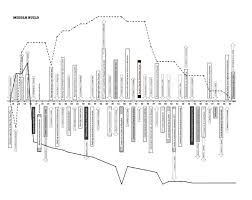 Step 3 is taking the values from the spreadsheet and putting them in a Graph Grid. Here the rise and fall of the story are mapped and the collision of characters’ internal and external conflicts are noted. The graph is bisected by a central line running left to right across the mddle with each scene number being assigned a seperate box. In the upper half are the positive forces of the story which Coyne terms Life. In the lower half are the negative forces of Death. Life and death conflict is central to the story.
Step 3 is taking the values from the spreadsheet and putting them in a Graph Grid. Here the rise and fall of the story are mapped and the collision of characters’ internal and external conflicts are noted. The graph is bisected by a central line running left to right across the mddle with each scene number being assigned a seperate box. In the upper half are the positive forces of the story which Coyne terms Life. In the lower half are the negative forces of Death. Life and death conflict is central to the story.
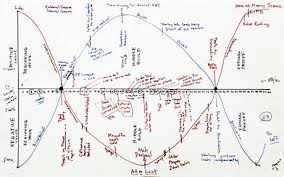 When the positive and negative strength of the values are plotted in relation to the scene, the overall story arch stands right out. Any interruption in the flow will show as a bend in the arch which is a red flag that something needs fixing. The flow is shown as a sine / cosine cruve. In Coyne’s analysis of The Silence Of The Lambs the beginning hook, the middle build, and the ending payoff neatly cross and coincidently seem to balance.
When the positive and negative strength of the values are plotted in relation to the scene, the overall story arch stands right out. Any interruption in the flow will show as a bend in the arch which is a red flag that something needs fixing. The flow is shown as a sine / cosine cruve. In Coyne’s analysis of The Silence Of The Lambs the beginning hook, the middle build, and the ending payoff neatly cross and coincidently seem to balance.
It’s no coincidence.
Author Thomas Harris deliberately planned The Silence Of The Lambs to have a storyline that flowed this way. It’s unknown if Harris used a similar foolscap / spreadsheet / graph system, but he arrived at a masterful result in one of the best thriller genre novels ever written.
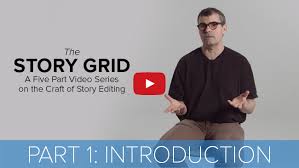 There’s far more to The Story Grid than I can cover in a short blog post. The hidden genius in this system is its effective use in outlining a novel, rather than waiting till drafts are done then analyzing flow.
There’s far more to The Story Grid than I can cover in a short blog post. The hidden genius in this system is its effective use in outlining a novel, rather than waiting till drafts are done then analyzing flow.
Here’s some links to Shawn Coyle’s The Story Grid.

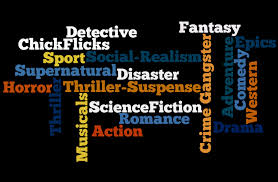
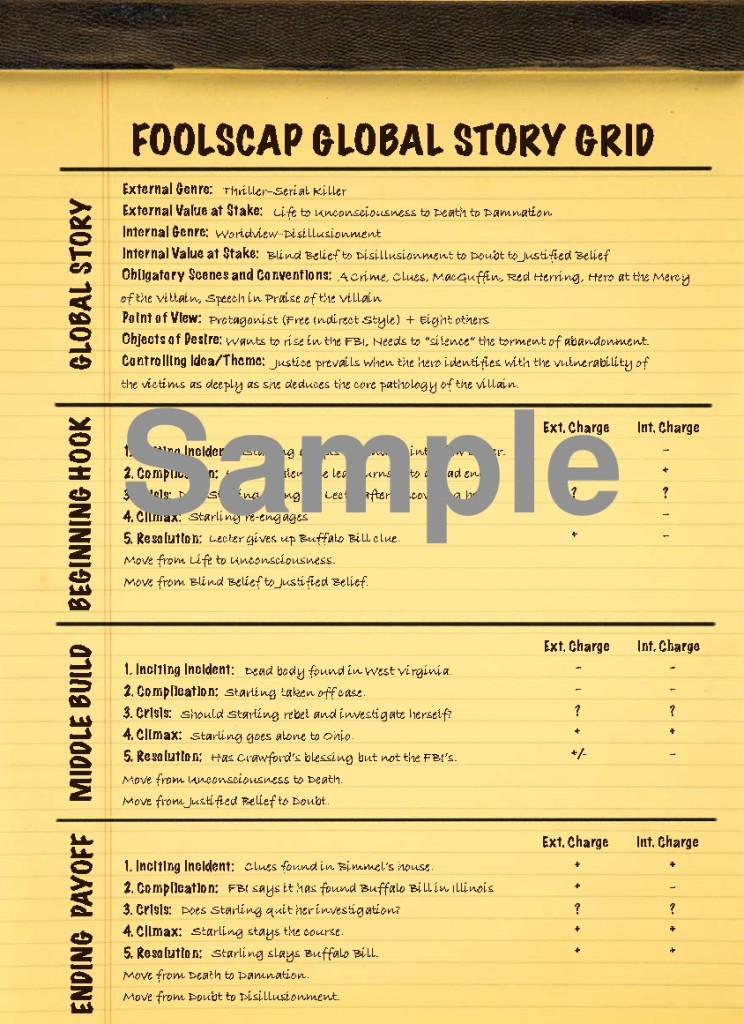
Can you help me with something ?
In the foolscap method, I don’t understand the “ext charge” and “int charge”. What does it mean ?
I don’t get the controlling idea/ theme as well as the stuff about “life” “death” “damnation” and “Unconsciousness”.
Thank you
It’s been a while since I did this piece on the Story Grid, Zack. Ext change is external and int change is internal which means how a character changes both inside and out. Story is all about change that results from conflict. As for the other stuff, I think it’s best that Shawn Coyne answers this and it’s all covered in his website. Here’s the link: http://www.storygrid.com/
Thanks for an excellent summary of an excellent tool. I was struggling with planning a novel I want to write. A friend pointed me to The Story Grid, I read the information on their site, and was able to sketch out 30 chapters in a few hours on a blank spreadsheet.
There is much work left to do yet on it, but The Story Grid was a huge help in planning.
I have introduced a budding crime writer in the UK to follow your blog, she enjoys it a lot.
Hi Noel! Nice to meet you & thanks for checking this out. I think Story Grid is the real deal and I’m going to plug my latest manuscript into it, then use the Grid in outlining my next. The transit points on the Life/Death line are scarily-necessary for a story to work… should a novel be designed around those moments?
Yeah, Shawn Coyle knows his stuff all right. Love your new background. It’s so…so…crime. Awesome! Was I part of the inspiration? LOL
With you about Shawn Coyne, Sue. I’d love to work with him but seeing his past client list, I think I’m a little out of his league 🙂
New background? That you inspired?? Lemme think… Oh, you don’t mean that Silence Of The Lambs photo… the one I took of the three, absolutely pristine, first edition hardcover copies that I got for twenty bucks at a used book store after you told me how hard it was to find even a used paperback of SOTL, never mind a hardcover, regardless of condition – which caused me to go on a hunt and stumble upon the find of the year and then I surprised the shit out of you by mailing you one? Is that what you mean? Well, if it is, don’t tell anyone that I still have two copies left, which I might be persuaded to part with… for the right price, of course 🙂
Luckily Shawn has trained and certified a team of 19 Story Grid Editors that have direct access to his assistance on their clients’ manuscripts.
Hi, Garry —
I was happy to see your masterful summary of “The Story Grid” today. I’m a fan of author-publisher Steven Pressfield and author-editor-publisher Shawn Coyne. Each in his own way has helped my story planning and writing, Just as you and “Dying Words” have helped my understanding of forensic details and given me superb ideas.
Thanks again!
Thanks, Judy. It’s so nice to hear that you’re getting good out of the material on DyingWords. I’ve known of Steven Pressfield but I stumbled upon Shawn Coyne and The Story Grid as I was researching self-editing tips. I recently read Story Grid and made pages of notes. This system really makes sense to me and I’m going to try it out on a novel manuscript that I’ve recently completed revised drafts of, but haven’t yet sent out for professional editing. I’m looking forward to seeing what happens and might do a follow-up post with the results. I hope it doesn’t send me back into a huge re-write (Gulp!)